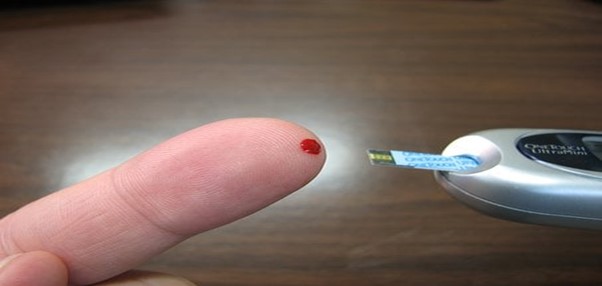Get in touch
To speak to someone about Blood Glucose Monitoring and Ketone Monitoring, contact our physical health team.
Phone: 0191 333 3584
What is a blood glucose reading?
Blood glucose levels are a measurement that shows how much glucose (sugar) is in a person’s blood. Sometimes these are called blood sugar or Blood Glucose Monitoring readings.
The reading is measured in mmol/l. This stands for millimoles per litre.
A mole is a scientific unit often used to measure chemicals.
It is important to maintain good glucose control to avoid major complications of diabetes effecting eyes, kidneys, brain, heart, and nerves.
High readings are referred to as hyperglycaemia and low readings, hypoglycaemia.

Continuous Glucose Monitoring (CGM) and Flash Monitoring
Both the CGM and the Flash monitoring are made up of:
- A sensor, which is a small device that is attached to the arm or the tummy. This senses how much glucose is in the fluid under the skin. This fluid is called interstitial fluid.
- A reader or receiver, which shows the results. You can also get the results on your smart phone.
CGM – The sensor sends results to the receiver on your phone every few minutes. Some types can send the results to an insulin pump and then you can see the glucose levels on the pump.
Flash – You will need to scan the sensor with the reader or with your phone to see the results.
If you use any of these systems, your nurse will still take Blood Glucose Readings and document the readings.
When should a blood glucose reading be taken?
Blood glucose readings are usually taken for patients who have diabetes. Frequency of monitoring is dependent on the type of diabetes you have. This is individual to each person:
- If you are prescribed insulin, blood glucose readings may be recorded 4 times a day. While in hospital, staff will usually want to obtain a blood glucose reading prior to insulin administration (and in some circumstances, another blood glucose reading after insulin administration).
- If you are taking tablets to control your diabetes, a blood glucose reading may be requested if your medication increases your risk of hypoglycaemia or if you have a history of hypoglycaemic episodes.
- If you are a diet controlled diabetic, blood glucose levels are not usually monitored routinely unless you have a history of hypoglycaemic episodes or if you become unwell.
There may be certain times when monitoring will need to be increased such as in pregnancy, consumption of steroids, being acutely unwell with either a physical or mental health condition, or when there is a significant change in diet.
If you are diabetic and appear unwell, we would always recommend checking your blood glucose levels regardless of other factors.
Blood glucose readings may also be requested without a diagnosis of diabetes, for example:
- If you become unwell
- If you have a decreased appetite
- And/or staff are concerned about your physical health.
Healthy target
Blood glucose readings can vary but as a general guide, a reading of 4-7mmol/l is considered ‘normal’ on awakening and before meals.
Some individuals’ ‘normal’ reading can be higher than this but under 4mmol/l is always considered as a low reading.
If a person’s ‘normal’ reading is higher than a general guide, under 5-6mmol/l would be considered as too low for that person.
Signs of hyperglycaemia and hypoglycaemia
Hyperglycaemia
- Tiredness and lethargy
- Thrush or other recurring bladder and skin infections
- Headaches
- Blurred vision
- Weight loss
- Feeling sick
Hypoglycaemia
Hypoglycaemia
- Passing more urine than normal, especially at night
- Being very thirsty
- Lips feeling tingly
- Feeling tearful
- Lack of concentration
- Night sweats
- Blurred vision
- Headaches
- Feeling sick
- Going pale
- Feeling shaky
- Being hungry
- Tiredness
- Feeling disorientated
- Sweating
- Being anxious or irritable
- Palpitations and a fast pulse
If the blood glucose reading is high, your nurse will report this to a doctor or physical healthcare practitioner. The urgency would be dependent on how high your reading is (considering what is a normal reading for you). Your ketone readings may also need to be checked at this time.
What is a ketone reading?
Ketone readings may be requested if there are concerns regarding your physical health, which may be a result of your diabetes i.e. consistently high blood glucose readings.
Our body should use insulin to transport glucose into our cells to be used for energy. If we don’t have enough insulin we cannot transport glucose into our cells, so it remains in our blood (hyperglycaemia).
When this happens, our body starts to use fat for energy. When our body uses fat for energy our liver starts to produce ketones.
When ketones build-up in the blood, they become acidic and may lead to something called diabetic ketoacidosis (DKA). DKA is considered a medical emergency and can be life-threatening.
When should a ketone reading be taken?
Ketones should be checked as soon as requested by the doctor or physical healthcare practitioner. A ketone reading is usually requested due to:
- A (continually) raised blood glucose reading of 15 mmol/l
- An added investigation if individual appears unwell
Ketones can be monitored using a dipstick or via a blood test. A dipstick does not provide an exact reading whereas a blood test using a ketone meter provides a more precise reading.
How to respond to a ketone reading
If you monitor your own ketone readings you should inform your nurse immediately of your results from a ketone reading (and especially if it is high), who can then pass the information onto the doctor or physical healthcare practitioner. Your nurse will undertake their own ketone reading using the Trust blood glucose and ketone meter. The doctor or physical healthcare practitioner will then advise accordingly to the reading.
L1176, v1, 12/9/2022 (archive 12/9/2025)